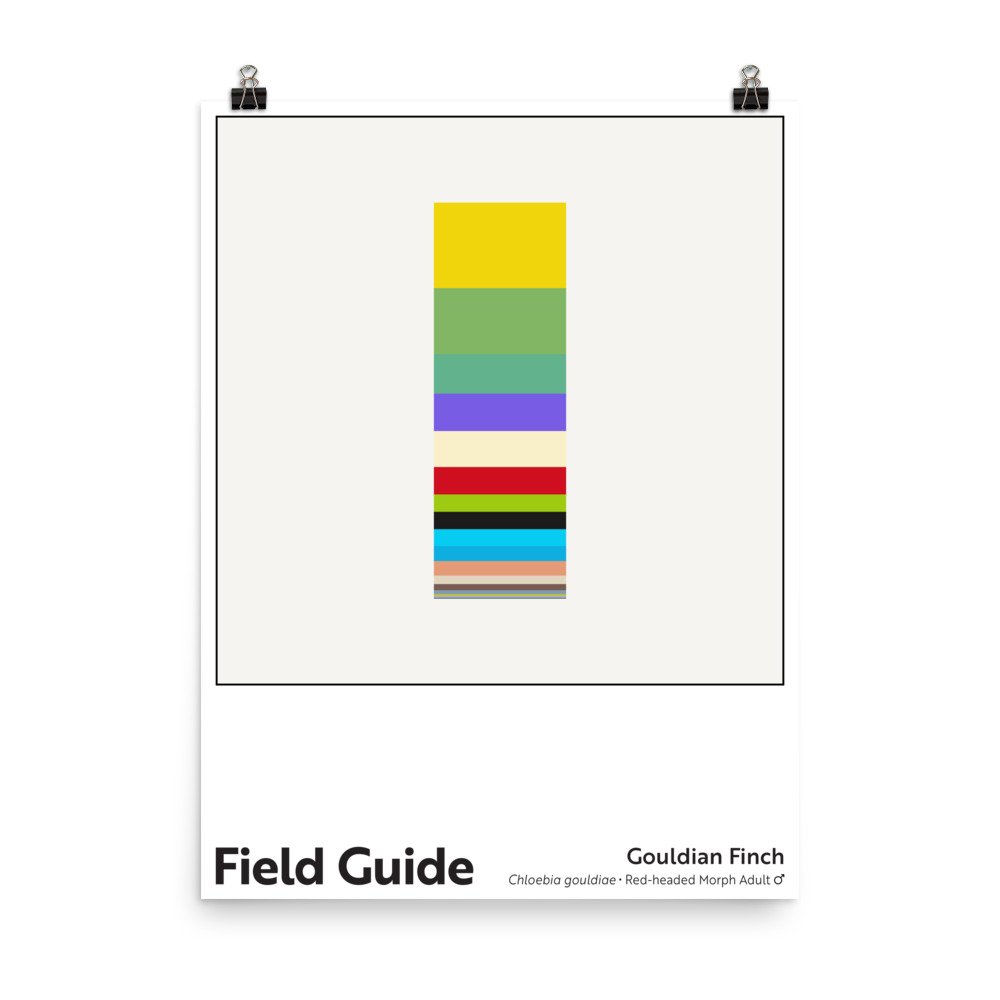 Image 1 of 2
Image 1 of 2

 Image 2 of 2
Image 2 of 2



Field Guide : Gouldian Finch (Male)
Unlimited edition. 18 x 24 inch, museum-quality poster on matte paper.
When I released the Field Guide poster for the male painted bunting, I described the bird as “exuberantly colored, seemingly decorated by a child determined to use every crayon in the box.” At the time, I hadn’t yet seen the male Gouldian finch. Great Goulda Mooga 😮, this one makes the first child look lazy!
To be fair, not all Gouldian finches are quite this flamboyant. The red-headed Gouldian finch is one of three color morphs, along with golden- and black-headed males, the latter being the most common; black-headed morphs account for 70% of the wild population and red-headed morphs, about 30%, with golden-headed morphs accounting for less than 1%. The morphs were once considered distinct species, and some researchers contend the interactions between the morphs offer a window into speciation. Normally, color morphs of a single species breed without issue, but that’s not so for the Gouldian finch; when two different morphs mate, genetic incompatibility causes many of their offspring – especially females – to die young. Researchers discovered that a female Gouldian finch chooses to hatch an even number of boys and girls if she has the same head color as her mate. If there's a mismatch (e.g., a red-headed finch breeding with a black-headed), the mom produces more males, thereby increasing her offspring’s survival rate. The mechanism for such sex selection is not yet known, but the genetic incompatibility suggests speciation is in progress.
The Gouldian finch is native to northern Australia, where an increase in wildfire frequency/scale along with livestock grazing pressure led to substantial declines in the bird’s population. The wildfires are particularly troublesome, as they reduce both the availability of seed and nesting tree hollows. Fortunately, the news isn’t all bad. Because of concerted conservation efforts, wild populations now appear to be holding steady. (Apparently, however, domestic cats remain a threat – no matter where you are in the world, please keep your cats indoors!)
Note: These archival poster prints feature rich, appealing colors. I encourage customers to take care in handling them until they are framed/protected for display; the darker colors on the matte paper can be scratched. They ship rolled, so customers need to flatten them before framing (or have their framer do so).
Charitable Sales Model: Whenever one of these poster prints is purchased, a charitable contribution equal to 10% of the print’s cost (or $3.60) is made to a nonprofit working to tackle environmental or social challenges. Read more about my charitable sales model here.
Unlimited edition. 18 x 24 inch, museum-quality poster on matte paper.
When I released the Field Guide poster for the male painted bunting, I described the bird as “exuberantly colored, seemingly decorated by a child determined to use every crayon in the box.” At the time, I hadn’t yet seen the male Gouldian finch. Great Goulda Mooga 😮, this one makes the first child look lazy!
To be fair, not all Gouldian finches are quite this flamboyant. The red-headed Gouldian finch is one of three color morphs, along with golden- and black-headed males, the latter being the most common; black-headed morphs account for 70% of the wild population and red-headed morphs, about 30%, with golden-headed morphs accounting for less than 1%. The morphs were once considered distinct species, and some researchers contend the interactions between the morphs offer a window into speciation. Normally, color morphs of a single species breed without issue, but that’s not so for the Gouldian finch; when two different morphs mate, genetic incompatibility causes many of their offspring – especially females – to die young. Researchers discovered that a female Gouldian finch chooses to hatch an even number of boys and girls if she has the same head color as her mate. If there's a mismatch (e.g., a red-headed finch breeding with a black-headed), the mom produces more males, thereby increasing her offspring’s survival rate. The mechanism for such sex selection is not yet known, but the genetic incompatibility suggests speciation is in progress.
The Gouldian finch is native to northern Australia, where an increase in wildfire frequency/scale along with livestock grazing pressure led to substantial declines in the bird’s population. The wildfires are particularly troublesome, as they reduce both the availability of seed and nesting tree hollows. Fortunately, the news isn’t all bad. Because of concerted conservation efforts, wild populations now appear to be holding steady. (Apparently, however, domestic cats remain a threat – no matter where you are in the world, please keep your cats indoors!)
Note: These archival poster prints feature rich, appealing colors. I encourage customers to take care in handling them until they are framed/protected for display; the darker colors on the matte paper can be scratched. They ship rolled, so customers need to flatten them before framing (or have their framer do so).
Charitable Sales Model: Whenever one of these poster prints is purchased, a charitable contribution equal to 10% of the print’s cost (or $3.60) is made to a nonprofit working to tackle environmental or social challenges. Read more about my charitable sales model here.